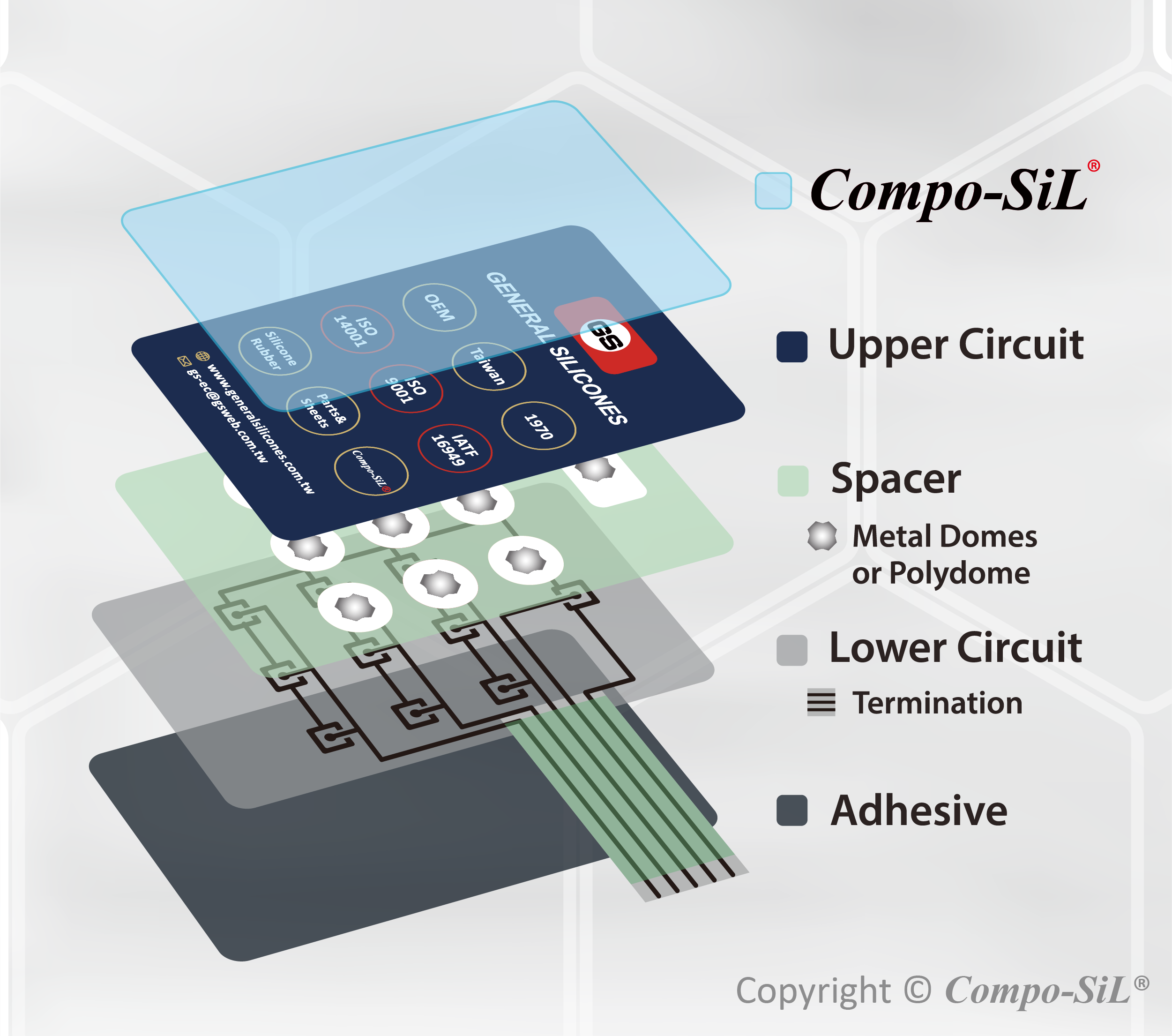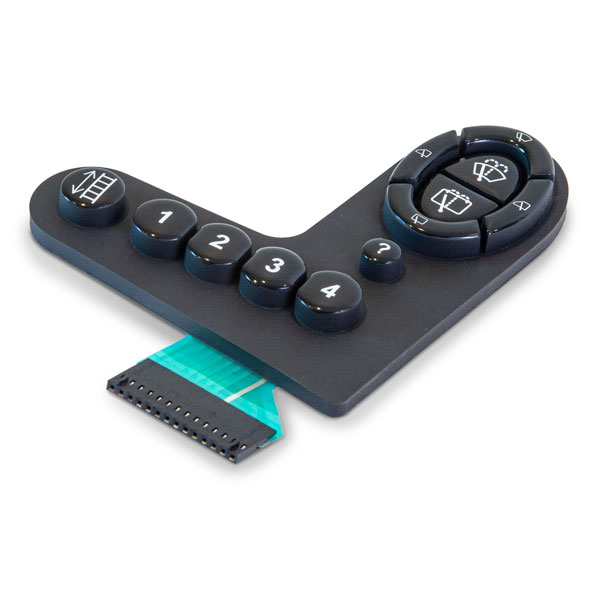Cutting-edge trends in membrane switch development
Everything About Membrane Switch Over: A Comprehensive Guide for Beginners
Membrane layer buttons are crucial elements in modern-day electronics, supplying an unique user interface for user communication - membrane switch. Their layered construction, including overlays and conductive traces, provides capability and toughness. Unlike traditional mechanical switches, membrane switches offer a sleek style and personalized alternatives. Comprehending their key features and advantages can change product style. The ins and outs of their application and design considerations warrant further expedition.
What Is a Membrane Change?
A membrane button is a type of electrical switch that includes a versatile membrane layer layered over a published circuit card. This design enables a sleek and compact user interface, frequently made use of in various electronic gadgets. Membrane layer switches are typically discovered in consumer home appliances, medical equipment, and industrial machinery as a result of their resilience and resistance to environmental factors.The construction usually consists of several layers, such as visuals overlays and glue backing, which supply tactile comments and secure the wiring beneath. The procedure of a membrane layer button is launched when stress is related to the surface area, finishing an electrical circuit.These switches are valued for their versatility, making it possible for custom-made layouts and printed graphics that accommodate specific interface. Their inconspicuous nature lowers room demands, making them suitable for applications where traditional buttons might not fit. In general, membrane switches supply a functional and visual option for modern electronic gadgets.
Key Parts of Membrane Layer Switches Over
Membrane changes make up numerous vital parts that add to their capability and efficiency. The leading layer, referred to as the overlay, offers the interface and is frequently published with graphics or icons. Under the overlay exists a spacer layer, which separates the conductive components and avoids unintentional activation. The next vital element is the visuals layer, which improves aesthetics and guarantees the toughness of the design.Conductive traces, typically made from products like silver or carbon, are printed on the circuit layer. When stress is put on the overlay, these traces enter into get in touch with, completing the circuit. Additionally, a backing layer provides structural support and can be made from materials such as polyester or polycarbonate. Together, these parts develop a reliable, straightforward interface ideal for various applications, from household appliances to industrial tools. Comprehending these aspects is essential for anybody interested in membrane layer switch technology.
How Membrane Layer Switches Work
Recognizing just how membrane layer switches over feature is necessary for valuing their prevalent usage in numerous gadgets. A membrane layer switch operates via a collection of layers, consisting of a visuals overlay, spacer, and a circuit layer. When stress is used to the overlay, it presses the spacer layer, allowing the circuit layer to make get in touch with and finish an electric circuit. This action sends out a signal to the device, motivating a response, such as turning on a light or turning on a function.Membrane switches over can be designed with different features, consisting of responsive feedback, backlighting, and personalized graphics, enhancing customer communication. Their building enables a closed layout, securing the interior parts from dirt, wetness, and contaminants. This sturdiness makes them ideal for diverse applications, from customer electronics to commercial equipment. On the whole, the simpleness and effectiveness of membrane switches add to their appeal in contemporary technology.
Advantages of Membrane Layer Switches Mechanical Switches
While mechanical switches have long been a staple in several gadgets, membrane switches over offer distinctive advantages that make them increasingly appealing. One significant benefit is their slim account, permitting more compact designs and better versatility in product advancement. Furthermore, membrane changes attribute an uniform surface area, which improves visual charm and simplifies cleansing, making them ideal for environments where hygiene is critical.Another benefit is their resistance to dirt and wetness. Unlike mechanical switches, which can be endangered by environmental factors, membrane layer buttons give a covered interface that safeguards versus contaminants - membrane switch. In addition, membrane switches typically have a longer lifespan as a result of fewer relocating parts, causing boosted durability and reliability.Cost-effectiveness is likewise a remarkable benefit, as membrane buttons can be produced in bulk with reduced manufacturing expenses. These variables combine to place membrane buttons as a functional alternative to standard mechanical choices in different applications
Common Applications of Membrane Changes
Membrane layer switches are widely made use of in numerous fields, especially in consumer electronics and industrial control board. In customer tools, they give a smooth, user-friendly user interface, while in commercial settings, they enhance durability content and functionality. Understanding these applications highlights the versatility and practicality of membrane buttons in modern technology.
Customer Electronic Devices Tools
As consumer electronics proceed to evolve, membrane switches have come to be a prominent choice for a variety of gadgets because of their versatility and smooth style. These switches are frequently found in smart devices, tablet computers, and see it here push-button controls, where area is limited and aesthetic appeals matter. Their low account and personalized layouts allow suppliers to produce straightforward interfaces that enhance the total individual experience. Additionally, membrane layer buttons are frequently utilized in home appliances such as microwaves and coffee manufacturers, providing instinctive control options while resisting dampness and dust. The toughness and dependability of membrane switches make them ideal for everyday consumer items, making sure durability and constant performance. In general, their combination in customer electronics reflects a mix of performance and contemporary design.
Industrial Control Panels
The applications of membrane changes extend beyond consumer electronic devices, locating significant use in commercial control board. These buttons are favored for their longevity and resistance to extreme atmospheres, making them suitable for producing and process control settings. They supply a dependable interface for operators to control machinery, display procedures, and change settings. Membrane layer switches can be personalized to fit certain functional needs, integrating features like backlighting and responsive comments, boosting individual experience. Their low-profile style enables assimilation into various tools, while their capacity to endure site spills, dirt, and severe temperature levels warranties longevity. Generally, membrane switches add to effective and risk-free procedure in commercial applications, demonstrating their flexibility and effectiveness in requiring atmospheres.
Factors To Consider for Designing Membrane Switches Over
When creating membrane switches, selecting the best materials is essential to guarantee toughness and capability. In addition, recognizing layer arrangement methods can considerably impact the button's performance and individual experience. These factors to consider play an important role in creating reliable and dependable membrane button designs.
Material Selection Importance
Material choice plays an important role in the design and functionality of membrane switches. The selected materials directly affect the button's resilience, tactile response, and overall visual. Secret factors to consider consist of the substratum, which need to offer architectural integrity while permitting adaptability, and the visuals overlay, which needs to be immune to put on and ecological aspects. Conductive materials should ensure trustworthy electrical performance, while adhesives have to supply strong bonding without compromising the button's operation. Additionally, compatibility with making processes and end-user environments is vital; products should withstand varying temperatures, moisture levels, and chemical direct exposure. Eventually, ideal product selection not just improves the membrane layer switch's efficiency however also adds to its longevity and individual complete satisfaction, making it a crucial facet of the style procedure.

Layer Configuration Methods

Frequently Asked Questions
For How Long Do Membrane Layer Switches Over Usually Last?
Membrane layer switches normally have a lifespan of 1 to 5 million cycles, depending upon use and ecological conditions. Variables such as design top quality and operating frequency considerably influence their resilience and general efficiency longevity.

Can Membrane Layer Switches Over Be Personalized for Particular Styles?
Membrane buttons can indeed be personalized to fit particular designs, allowing for varied forms, shades, and capabilities. This convenience makes it possible for makers to tailor these switches to fulfill special aesthetic and functional needs effectively.
What Products Are Utilized in Membrane Layer Change Construction?
Membrane layer switches are typically built using materials such as polyester, polycarbonate, and adhesive layers. These materials provide adaptability, resistance, and resilience to environmental variables, guaranteeing the buttons function successfully in different applications and problems.
Are Membrane Layer Switches Water Resistant or Resistant to Moisture?
Membrane switches can be created to be moisture-resistant, using specialized materials and finishes. Nonetheless, their waterproof capacities depend on building high quality and certain applications, making it important to evaluate needs for optimal efficiency in different atmospheres.
Just How Are Membrane Layer Changes Fixed if Harmed?
Fixing broken membrane switches over typically entails changing the influenced layer or circuit. Technicians might additionally use conductive glue or make use of specialized fixing packages, making certain performance is brought back without full substitute of the entire switch setting up. Unlike typical mechanical switches, membrane switches present a smooth design and personalized choices. A membrane layer switch is a kind of electric switch that is composed of an adaptable membrane layer layered over a printed circuit board. The operation of a membrane layer switch is launched when pressure is used to the surface, finishing an electrical circuit.These buttons are valued for their convenience, allowing customized designs and published graphics that cater to details individual interfaces. While mechanical buttons have actually long been a staple in lots of devices, membrane layer switches deal distinct advantages that make them significantly appealing. Membrane buttons usually have a longer lifespan due to less relocating parts, resulting in boosted toughness and reliability.Cost-effectiveness is also a remarkable advantage, as membrane switches can be generated in bulk with reduced manufacturing expenses.